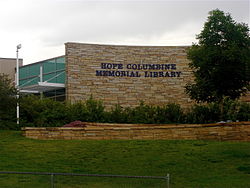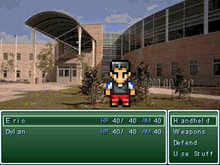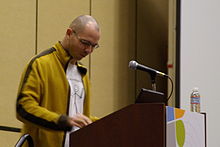
The Columbine High School massacre, commonly referred to as Columbine, was a school shooting and attempted bombing that occurred on April 20, 1999, at Columbine High School in Columbine, Colorado, United States. The perpetrators, twelfth-grade students Eric Harris and Dylan Klebold, murdered twelve students and one teacher. Ten of the twelve students killed were in the school library, where Harris and Klebold subsequently committed suicide. Twenty-one additional people were injured by gunshots, and gunfire was also exchanged with the police. Another three people were injured trying to escape. The Columbine massacre was the deadliest mass shooting at a high school in U.S. history, until it was surpassed by the Parkland high school shooting in February 2018. Columbine still remains the deadliest school shooting to occur in the U.S. state of Colorado.

Eric David Harris and Dylan Bennet Klebold were an American mass murderer duo who perpetrated the Columbine High School massacre on April 20, 1999. Harris and Klebold killed 13 people and wounded 24 others at Columbine High School, where they were seniors, in Columbine, Colorado. After killing most of their victims in the school's library, they died by suicide. At the time, it was the deadliest high school shooting in U.S. history. The ensuing media frenzy and moral panic led to "Columbine" becoming a byword for school shootings, and becoming one of the most infamous mass shootings ever perpetrated in the United States.

Cassie René Bernall was an American student who was killed in the Columbine High School massacre, where 11 more students and a teacher were killed by Eric Harris and Dylan Klebold, who then committed suicide. It was reported that Bernall had been asked whether or not she believed in God, and she said "Yes", before being shot during the massacre. However, investigators concluded the person who was asked about her belief in God was Valeen Schnurr, who survived the shooting.

Rachel Joy Scott was an American student who was the first fatality of the Columbine High School massacre, in which 11 other students and a teacher were also murdered by Eric Harris and Dylan Klebold, who then died by suicide.

Columbine High School (CHS) is a public high school in Columbine, Colorado, United States, in the Denver metropolitan area. It is part of the Jefferson County Public Schools district.

The Slamdance Film Festival is an annual film festival focused on emerging artists. The annual week-long festival takes place in Park City, Utah, in late January and is the main event organized by the year-round Slamdance organization, which also hosts a screenplay competition, workshops, screenings throughout the year and events with an emphasis on independent films with budgets under US$1 million.
Manifesto Games was an ecommerce retailer of downloadable computer games, specializing in independently developed games aimed at hardcore gamers. It was founded in October 2005 by Greg Costikyan and Johnny L. Wilson, former editor of Computer Gaming World, and is based in New York City. The company was announced September 29, 2005. Costikyan was the company's CEO while Wilson was executive vice president for community and content. On June 23, 2009, Costikyan announced that Manifesto was closing its doors, citing the 2008-2009 economic downturn, a lack of venture capital, and problems successfully marketing the company as a destination for independent games.

The Dawson College shooting occurred on September 13, 2006, at Dawson College, a CEGEP located in downtown Montreal, Quebec, Canada. The perpetrator, Kimveer Singh Gill, began shooting outside the de Maisonneuve Boulevard entrance to the school, and moved towards the atrium by the cafeteria on the main floor. One victim died at the scene, while another 19 were injured, eight of whom were listed in critical condition, with six requiring surgery. The shooter later committed suicide, after being shot in the arm by a police officer. It was the third fatal school shooting in Montreal, after the École Polytechnique massacre in 1989 and the shooting spree at Concordia University in 1992.

Danny A. Ledonne is an American film director and former video game developer. From 2011 to 2014, he worked as a professor in Film and Media Arts at American University, served on the board of the Southern Colorado Film Commission, and became the director for the 2015 edition of the festival. He is known for the documentary Playing Columbine, about the controversy surrounding his 2005 video game Super Columbine Massacre RPG!.
The 2000s was the fourth decade of the video game industry. It was a decade that was primarily dominated by Sony, Nintendo, newcomer Microsoft, and their respective systems. Sega, being Nintendo's main rival in the 1980s and 1990s, left the console market in 2002 in favor of returning to third-party development, as they once were. Overall the decade saw the last of the low resolution three-dimensional polygons of the 1990s with the emergence of high definition games, and often focused on developing immersive and interactive environments, implementing realistic physics, and improving artificial intelligence. The sixth and seventh generation of video game consoles went on sale, including the Dreamcast, PlayStation 2, Xbox, GameCube, Xbox 360, PlayStation 3, Wii, Game Boy Advance, Nintendo DS and PlayStation Portable. Notable games released in the 2000s included Half-Life 2, Wii Sports, Grand Theft Auto III, BioShock, The Sims, Metroid Prime, Burnout 3: Takedown,Tony Hawk's Pro Skater 2, Resident Evil 4, The Legend of Zelda: The Wind Waker, Shadow of the Colossus,Grand Theft Auto: Vice City, Star Wars: Knights of the Old Republic, LittleBigPlanet, The Elder Scrolls III: Morrowind,World of Warcraft, Final Fantasy X, Perfect Dark, God of War, Left 4 Dead, Batman: Arkham Asylum, Counter-Strike, Prince of Persia: The Sands of Time,Diablo II, Pokémon Ruby and Sapphire,The Sims, The Elder Scrolls IV: Oblivion,Super Smash Bros. Melee, Grand Theft Auto: San Andreas, Gears of War, Max Payne, Super Mario Galaxy, Halo: Combat Evolved, Tony Hawk´s Pro Skater 3, Guitar Hero, Devil May Cry, Jak and Daxter: The Precursor Legacy, Ratchet & Clank, Sly Cooper and the Thievius Raccoonus,Hitman: Blood Money, Grand Theft Auto IV, Halo 2, The Legend of Zelda: Twilight Princess, Metal Gear Solid 2: Sons of Liberty, Fallout 3, Super Mario Sunshine, Rock Band, Beyond Good & Evil,Portal, Ico, Jet Set Radio, Silent Hill 2, Psychonauts, Uncharted 2: Among Thieves,Halo 3, and Call of Duty 4: Modern Warfare.

V-Tech Rampage is a controversial amateur action video game that recreates the 2007 Virginia Tech shooting on the campus of Virginia Tech in Blacksburg, Virginia, United States. The game was created by 21-year-old Ryan Lambourn from Australia. The Flash-based game came to light when it was uploaded to Newgrounds using Lambourn's screen name Master PiGPEN.

Muslim Massacre: The Game of Modern Religious Genocide is a controversial 2008 amateur video game by former Something Awful forum member Eric Vaughn under the screen name "Sigvatr". It is a top-down shoot 'em up video game. The aim of the game is to kill all the Muslims that appear on the screen – in the words of its creator, "take control of the American hero and wipe out the Muslim race with an arsenal of the world's most destructive weapons."

Playing Columbine is a 2008 American documentary film produced and edited by American independent filmmaker Danny Ledonne. The film follows the video game Super Columbine Massacre RPG! in which players experience the Columbine High School massacre through the eyes of the murderers, Eric Harris and Dylan Klebold.

Columbine is a non-fiction book written by Dave Cullen and published by Twelve on April 6, 2009. It is an examination of the Columbine High School massacre, on April 20, 1999, and the perpetrators Eric Harris and Dylan Klebold. The book covers two major storylines: the killers' evolution leading up to the attack, and the survivors' struggles with the aftermath over the next decade. Chapters alternate between the two stories. Graphic depictions of parts of the attack are included, in addition to the actual names of friends and family.

Following the massacre at Columbine High School on April 20, 1999, one common view was that the violent actions perpetrated by the two shooters, Eric Harris and Dylan Klebold, were due to violent influences in entertainment, specifically those in the music of Marilyn Manson.

A Mother's Reckoning: Living in the Aftermath of Tragedy is a 2016 memoir by Sue Klebold, the mother of Dylan Klebold. Along with Eric Harris, Dylan was one of the perpetrators of the Columbine High School massacre in 1999. The book details the childhood and teenage years of her son, and what she says are signs she missed that Dylan was suffering from clinical depression. The book also examines her grieving process in dealing with the fallout of the massacre.

Susan Francis Klebold is an American activist and author whose son, American mass murderer Dylan Klebold, was one of the perpetrators of the Columbine High School shooting in 1999. After the massacre, she wrote A Mother's Reckoning, a book about the signs and possible motives she missed of Dylan's mental state.

The Columbine Memorial is a memorial in Columbine, Colorado, that honors the deceased and injured victims, survivors, rescuers, and all who were affected by the Columbine High School massacre on April 20, 1999. The memorial is located in Clement Park, which is behind Columbine High School, the site of the massacre. It is operated by a non-profit institution whose mission is to operate the memorial and its upkeeping.

The Columbine effect is the legacy and impact of the 1999 Columbine High School massacre. The shooting has had an effect on school safety, policing tactics, prevention methods, and inspired numerous copycat crimes, with many killers taking their inspiration from Eric Harris and Dylan Klebold by describing the two perpetrators as being martyrs or heroes.

No Easy Answers: The Truth Behind Death at Columbine is a 2002 non-fiction book by Brooks Brown and Rob Merritt about the Columbine High School massacre. Brown was a student at Columbine High School at the time of the shooting and a friend of the perpetrators, Eric Harris and Dylan Klebold. The book recounts Brown's experiences growing up as close friends with Klebold, his time as a student at Columbine, and his experiences with media, police, and school authorities following the shooting.




















